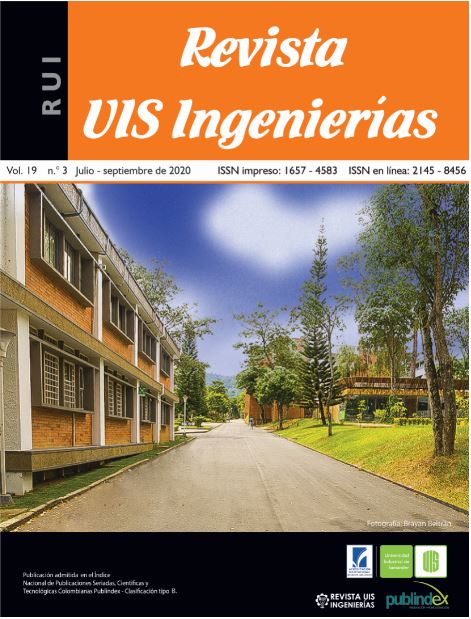Publicado 2020-05-11
Palabras clave
- supercondensadores,
- derivada conformable,
- circuito equivalente,
- validación experimental,
- operador conformable
Cómo citar
Derechos de autor 2020 Revista UIS Ingenierías

Esta obra está bajo una licencia internacional Creative Commons Atribución-SinDerivadas 4.0.
Resumen
Este artículo propone un nuevo circuito equivalente para modelar supercondensadores. El circuito propuesto es un arreglo de circuitos RC serie descritos por ecuaciones diferenciales fraccionarias conformables. Se implementa un algoritmo de identificación de parámetros del circuito equivalente, que utiliza como entrada datos experimentales. Los resultados de validación obtenidos muestran que un circuito equivalente que emplea el operador conformable puede ser utilizado para modelar el comportamiento real del supercondensador.
Descargas
Referencias
10.1109/TIA.2007.895768
[2] J. Pegueroles-Queralt, F. D. Bianchi, O. Gomis-Bellmunt, “A Power Smoothing System Based on Supercapacitors for Renewable Distributed Generation,” IEEE Transactions on Industrial Electronics, vol. 62, no. 1, pp. 343 - 350, 2015, doi: 10.1109/TIE.2014.2327554
[3] N. R. Tummuru, M. K. Mishra, S. Srinivas, “Dynamic energy management of renewable grid integrated hybrid energy storage system,” IEEE Transactions on Industrial Electronics, vol. 62, no. 12, pp. 7728–7737, 2015, doi: 10.1016/j.energy.2018.08.016
[4] J. S. Martínez, J. Mulot, F. Harel, D. Hissel, M.C. Pera, R. I. John, M. Amiet, “Experimental validation of a type-2 fuzzy logic controller for energy management in hybrid electrical vehicles,” Engineering Applications of Artificial Intelligence, vol. 26, no. 7, pp. 1772–1779, 2013, doi: 10.1016/j.engappai.2012.12.008
[5] W. Lhomme et al., “IEEE VTS Motor Vehicles Challenge 2019 - Energy Management of a Dual-Mode Locomotive,” 2018 IEEE Vehicle Power and Propulsion Conference (VPPC), Chicago, IL, 2018, pp. 1-6, doi: 10.1109/VPPC.2018.8605044
[6] A. Lahyani, P. Venet, A. Guermazi, A. Troudi, "Battery/Supercapacitors Combination in Uninterruptible Power Supply (UPS),” IEEE Transactions on Power Electronics, vol. 28, no. 4, pp. 1509-1522, 2013, doi: 10.1109/TPEL.2012.2210736
[7] L. Zubieta, R. Bonert, “Characterization of double-layer capacitors (DLCs) for power electronics applications,” Conference Record of 1998 IEEE Industry Applications Conference. Thirty-Third IAS Annual Meeting (Cat. No.98CH36242), St. Louis, MO, USA, 1998, pp. 1149 - 1154 vol. 2, doi: 10.1109/IAS.1998.730292
[8] J. Solano, D. Hissel, M. Pera, “Modeling and Parameter Identification of Ultracapacitors for Hybrid Electrical Vehicles,” 2013 IEEE Vehicle Power and Propulsion Conference (VPPC), Beijing, 2013, pp. 1-4, doi: 10.1109/VPPC.2013.6671692
[9] J. Tian, R. Xiong, Q. Yu, “Fractional-Order Model-Based Incremental Capacity Analysis for Degradation State Recognition of Lithium-Ion Batteries,” IEEE Transactions on Industrial Electronics, vol. 66, no. 2, pp. 1576-1584, 2019, doi: 10.1109/TIE.2018.2798606
[10] L. Martinez, J. Rosales, C. Carreño, J. Lozano, “Electrical circuits described by fractional conformable derivative,” International Journal of Circuit Theory and Applications, vol. 46, no. 5, pp. 1091–1100, 2018, doi: 10.1002/cta.2475
[11] V. Morales-Delgado, J. Gómez-Aguilar, M. TanecoHernandez, “Analytical solutions of electrical circuits described by fractional conformable derivatives in liouville-caputo sense,” AEU-International Journal of Electronics and Communications, vol. 85, pp. 108–117, 2018, doi: /10.1016/j.aeue.2017.12.031
[12] E. C. de Oliveira, J. A. T. Machado, “A review of definitions for fractional derivatives and integral,” Mathematical Problems in Engineering, vol. 2014, pp. 1–6, 2014, doi: 10.1155/2014/238459
[13] G. S. Teodoro, J. T. Machado, E. C. de Oliveira, “A review of definitions of fractional derivatives and other operators,” Journal of Computational Physics, vol. 388, pp. 195 - 208, 2019, doi: 10.1016/j.jcp.2019.03.008
[14] M. Caputo, M. Fabrizio, “A new definition of fractional derivative without singular kernel,” Progr. Fract. Differ. Appl, vol. 1, no. 2, pp. 1–13, 2015, doi: 10.12785/pfda/010201
[15] R. Khalil, M. Al Horani, A. Yousef, M. Sababheh, “A new definition of fractional derivative,” Journal of Computational and Applied Mathematics, vol. 264, pp. 65–70, 2014, doi: 10.1016/j.cam.2014.01.002
[16] A. Pandolfo, A. Hollenkamp, “Carbon properties and their role in supercapacitors,” Journal of power sources, vol. 157, no. 1, pp. 11–27, 2006, doi: 10.1016/j.jpowsour.2006.02.065

